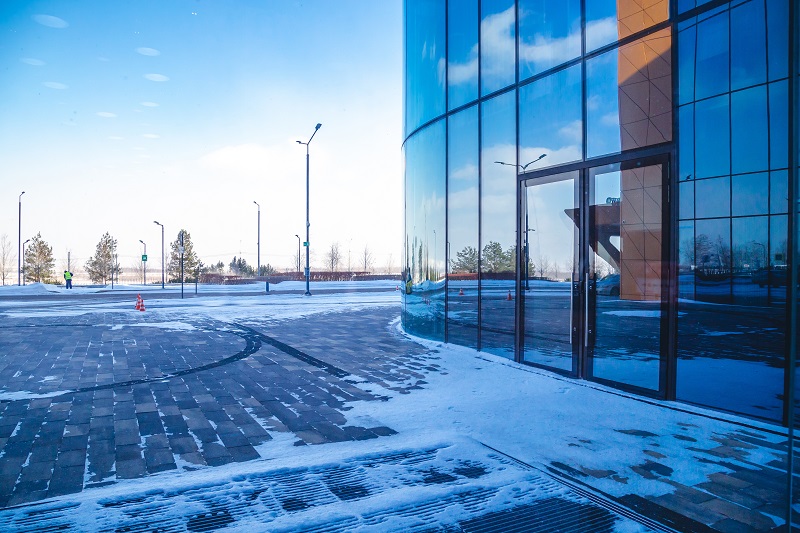Home / Top tips for getting your business’ health & safety ready for winter
Insights
Winter is coming, the days are getting shorter and the weather is becoming far more unpredictable. But what health and safety procedures do you need to take to keep your business and employees safe this winter.
Here are our top tips for getting your business safe this winter.
Winter Driving
- Plan your route according to the driving conditions allowing extra time for your journey.
- Check your vehicle before you set off and pack an emergency kit; hi-vis jacket, boots, blanket, food and water, de-icing equipment, torch, tow rope, hazard warning triangle, shovel and a fully charged mobile phone.
- Check weather reports prior to and during your journey.
- Keep your fuel tank near to full to ensure that you don’t run out.
- Be cautious when driving through flooded areas, avoid areas of deep water where possible.
- On ice and snow, accelerate and decelerate smoothly and gradually; always aim to maintain a constant speed.
- Stopping distances in ice and snow can be up to ten times longer. Make sure you can stop within the distance you can see to be clear in front of you.
- If you get caught in heavy snow, stay with your vehicle, and call your breakdown service or the emergency services, as appropriate.
- Use your engine to keep warm where it is safe to do so i.e., where vehicle emissions can be released to air.
Travelling on Foot to work
- Plan your route before setting off. Take it slowly and allow yourself extra time wearing sturdy footwear with good grip.
- Remain vigilant to underfoot conditions. Some places will remain icy for longer than others.
- Always keep to footpaths, don’t take short cuts and never cross frozen water.
Keeping Warm at work
- It is important you keep warm both indoors and out.
- When you go out, be sure you are dressed for the weather.
- During the winter months, make sure you wear warm layers under your coat, wear gloves and a hat; this is very important as a lot of your body heat is lost through your head.
- Warm shoes or boots with good grips are also important.
Lighting levels in work
- Is there is enough lighting around the site for all planned activities to be able to see and avoid hazards that might be on the ground?
- Walk the main internal and external routes that operatives use throughout their working day. It is important to do this both inside and outside of the workplace, as the effect of light changes during the day. If you can’t see hazards on the ground, you will need to improve the lighting (e.g., local and task lighting).
Wet and Decaying Leaves on work premises
- Fallen leaves that become wet or have started to decay can create slip risks in two ways - they hide any hazard that may be on the path or they themselves create a slip risk. Put in place a procedure for removing leaves at regular intervals as the leaves are falling.
Rainwater
In dealing with rainwater:
- When fitting external paved areas ensure that the material used will be slip resistant when wet.
- Discourage people from taking shortcuts over grass or dirt which are likely to become slippery when wet. Consider converting existing shortcuts into proper paths or supply temporary matting and removing standing water.
Wintery Conditions - Ice, Frost and Snow
- Slip and trip accidents increase during the Autumn and Winter season for several reasons: there is less daylight, leaves fall onto paths and become wet and slippery and cold weather spells cause ice and snow to build up on paths and surfaces.
- There are effective actions that we can take to reduce the risk of a slip or trip. Regardless of the size of your site, always ensure that regularly used walkways, access / egress routes are promptly tackled. Discuss current or potential areas that may cause ongoing risks as the winter weather begins to bite.
- To reduce the risk of slips on ice, frost or snow, you need to assess the risk and put in a system to manage it. Discuss common areas with Clients and agree who has responsibility for managing during the construction phase of the project.
- Identify the outdoor areas used by pedestrians most likely to be affected by ice, such as building entrances, car parks, waste disposal areas, pedestrian walkways, shortcuts, sloped areas and areas constantly in the shade or wet.
- Monitor the temperature, as prevention is key. Use technology including apps to get weekly / daily weather forecasts https://play.google.com/store/apps/details?id=uk.gov.metoffice.weather.android&hl=en_GB
- Put a procedure in place to prevent an icy surface forming and/or keep pedestrians off the slippery surface.
- Use grit (as detailed below) or similar, on areas prone to be slippery in frosty, icy conditions.
- Consider covering walkways e.g., by an canopy high enough for people to walk through or use an insulating material on smaller areas overnight.
- Divert pedestrians to less slippery walkways and barrier off existing ones and provide warning signage.
- If warning cones are used, remember to remove them once the hazard has passed or they will eventually be ignored.
Gritting your work premises
- The most common method used to de-ice floors is gritting as it is relatively cheap, quick to apply and easy to spread. Rock salt (plain and treated) is the most commonly used ‘grit’. It is the substance used on public roads by the highway’s authority.
- Salt can stop ice forming and cause existing ice or snow to melt. It is most effective when it is ground down, but this will take far longer on pedestrian areas than on roads.
- Gritting should be carried out when frost, ice or snow is forecast or when walkways are likely to be damp or wet and the floor temperatures are at, or below freezing. The best times are early in evening before the frost settles and/or early in the morning before employees arrive. Salt doesn’t work instantly; it needs enough time to dissolve into the moisture on the floor.
- If you grit when it is raining heavily the salt will be washed away, causing a problem if the rain then turns to snow. Compacted snow, which turns to ice, is difficult to treat effectively with grit. Be aware that ‘dawn frost’ can occur on dry surfaces, when early morning dew forms and freezes on impact with the cold surface. It can be difficult to predict when or where this condition will occur.
General advice to prevent Slips and trips at work
- Concentrate on where you're going, what you're doing and what lies ahead.
- Pay attention to your movements and surroundings, do not get distracted by conversations with colleagues or phone calls. Stop walking, finish the conversation and then proceed on your way.
- Take responsibility for reporting, removing, or avoiding hazards in your path. Don’t leave them for the next person to clear up.
- Wear appropriate footwear with anti-slip soles (where applicable).
- Walk, don't run.
- Remove or clean wet, muddy footwear when entering buildings.
- Report any defective or inadequate lighting.
- Watch out for floors that are uneven, have holes, are wet, icy or have snow deposited. Report risky areas to management so they can be addressed.
- When carrying loads ensure that you have good visibility in front of you.
- Follow local signage and demarcated pedestrian routes when the weather is poor.
- Use extra caution when walking on slippery surfaces, lean slightly forward and scoot your feet or take small steps. Do not run or take large strides and slow down while rounding corners, preferably with your hands out of your pockets in case you fall!
Did you know, we have an award-winning HR & Health and Safety platform?
Do you need more advice on how you can support your business and employees? Our expert HR & Health and Safety consultants are here to help you.






